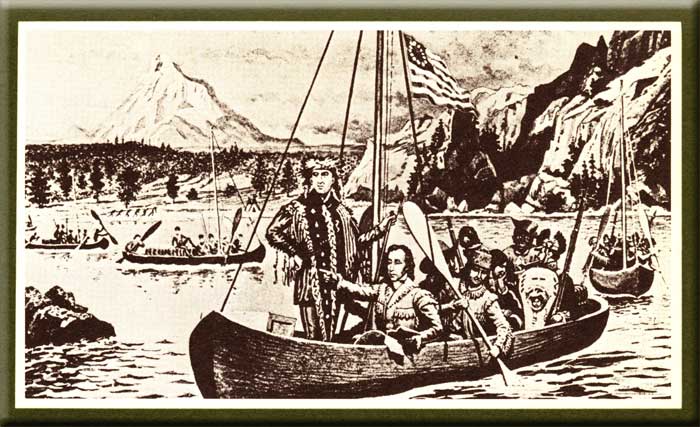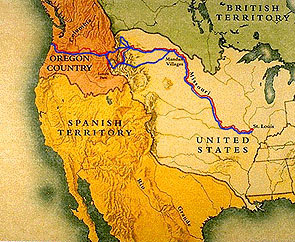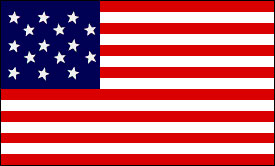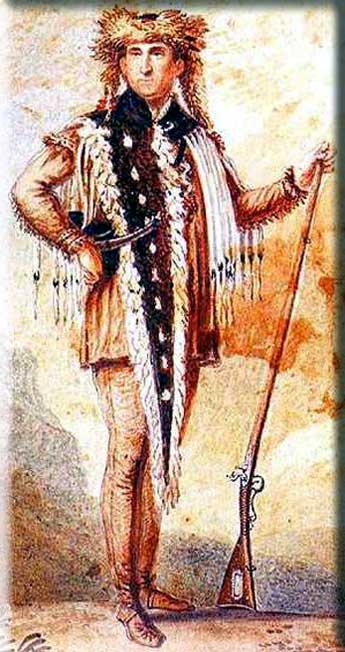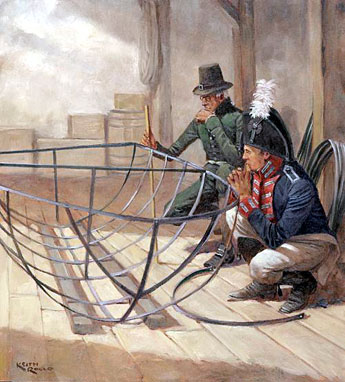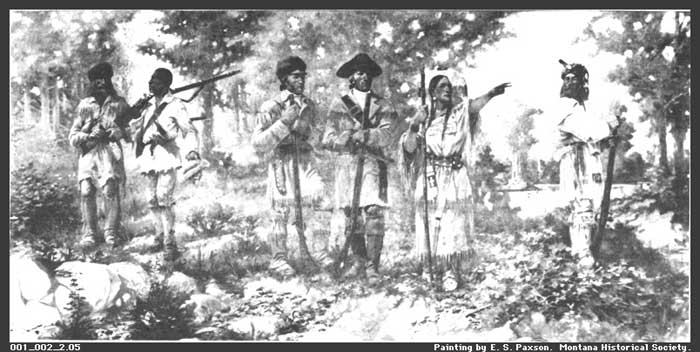|
Initially the expedition
was supposed to be secret because it had to be carried out
through the French territories.
|
|
In 1803 Napoleonic France,
fully indebted for the wars that Bonaparte was leading in Europe, sold
for a modest figure (15 million dollars) to Thomas Jefferson the immense
territories west of the Mississippi which were colonized since the 1628
from
Robert de La Salle.
The shipment was therefore organized officially.
|
|
Starting from 1804 Jefferson gave to
the two officials,captains Meriwether Lewis and William Clark, the
mission to explore the western territories from the Mississippi.
They left 14 May 1804 on three small boats loaded with supplies,
medicines and equipments. They were accompained by 14 soldiers, nine
pioneers, two french boat men, one interpreter, Clark's black servant,
two horses and a dog,
Seamann,
property of Lewis. Officially it was a trade and economic mission.
It came in fact from the decision adopted in the 1796 from the Congress,
looking for "the free trade" with the Indians to put into effect through
small farms.
This system was choosen to protect the Indians from the criminal
imbezzlements of the private traders, that more usually offered alcool
rather than money or useful merchandises.
Effectively, where it was applied, it carried a sure improvement in the
relationships between the two races. Jefferson moreover thought to
extend it to all the territories under the control
of the United States. |
|
«Jefferson's pacifism, its sincere desire to
reserve to the Indians the same rights of which they benefitted before
the arrival of the white men, dictated him ideal solutions», writes
Jean-Louis Rieupeyrout, author of colorful and well documented history
of the Far West in the "Monticello
tales" (Monticello is the Italian name that Jefferson - that spoke
currently Italian and was an
aficionado of
Cesare
Beccaria - had given to his estate). The
civilization would have definitively and favorably influenced the "wild
one", in the measure in which the "civilizing" had been animated from
the generosity, the wisdom and the liberalism. These were Jefferson firm
belief of fervent illuminist.
This attitude of the President attracted the attention of the
representatives on the tribes insediate along the Missouri, which were
trading furs with the English, in spite of the natural facilitations
offered to the Americans.
Therefore it had made to vote a financing of two thousand and five
hundred dollars for the expedition of Lewis (its particular secretary),
and Clark.
|
|
To both Jefferson he recommends to assume a
friendly and conciliating attitude
towards the Indians. |
|
«Convince
them that our purposes are disinterested»,
writes they,
«but
only after you have emphasized that the United States within a year must
take possession of all the Mississippi river area».
In two years they explored an immense territory, meeting tribe barely
known at that time,
such as the Oto, the Omaha, the Missouri. They met with warlike Teton
Sioux, familiarized with the beautiful women of the Ankara, obtained
great help from a girl of Shoshone origin named
Sacagawea
because she knew perfectly the places.
Without that young girl, her dedication and wisdom, probably the mission
would have had a different ending. They discovered rivers, mountain
chains and falls, reaching the Shoshone lands and then, after crossing
Bitterroot Valley, arriving to those of the Nez Percez and the Flat
Heads. Canoeing on the Clearwater River they first reached the Snake
River and finally the Columbia River camping where today the cities of
Clarkston and Lewiston rise. |
|
|
|
Finally, after covering
7689 miles, they reached the Pacific Ocean: their travel, opening the
road of the West, would have changed the history of the United States.
|
|
Lewis will write a report for Thomas Jefferson. In his opinion
the British threat on the economy of the region of the Pacific and along
the course of Columbia is obvious. To avoid thie threat immediate
decisions are necessary.
He proposes the creation of several points of American trade. One of
these would have had to be placed on the eastern side of the Rocky
Mountains, to collect the furs (this is the region in which
«more
than in every other part of the world the beavers and the otters abound»).
Then on a second point on the western side would have boarded them for
the shipment to China, the most important purchaser.
«If
it were succeeded to make them to arrive here towards 10 August, the
cargos could arrive to Canton nearly a year before the English ones.
These last ones in fact are disadvantaged by the longest travel, from
the mountains to Montreal first, then to London and finally in China,
passing for the Cape of Good Hope».
|
|
